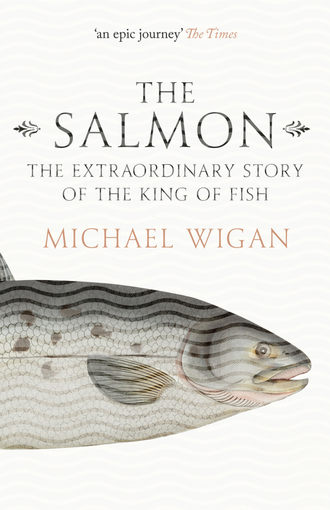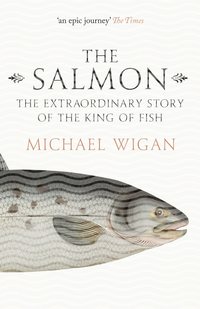
Полная версия
The Salmon: The Extraordinary Story of the King of Fish
London was distinct from European markets in demanding salmon that was fresh. Unadulterated salmon was unloaded in London from boats sailing out of Berwick-on-Tweed and Perth. Again, eighteenth-century Londoners were fastidious. Prices of salmon tumbled as the season wore on. Early-season salmon which travelled in cold weather fetched prices nearly two-thirds higher than later in May, by which time salmon were abundant and freshness was fighting higher temperatures. However, transport in ‘kitts’ (barrels of 30–40 pounds of fish) was quick: fast cutters of 60–70 tons could whack down from Perth on favourable north winds in 50 hours. When Londoners had to hold their noses the fish were pickled and sent abroad.
Although history recounts that the first salmon packed on ice travelled from Perth to London in the 1780s, Galen, the Roman writer, had reported fish being preserved in snow in the second century. Preservation in frozen water was hardly a sophisticated trick anyway; by the time full-scale salmon netting was underway in the eighteenth century there were ice houses at the mouths of many salmon rivers in Scotland. Winter ice was chopped and packed inside these stone-vaulted, partly subterranean buildings, then sealed off. Salmon were loaded in as and when they were caught.
The volume of trade can be established in some of the local details. The big rivers have clear records, at least of official catches. The Tay is Scotland’s premier salmon water. By 1807 the average catch of grilse and salmon was 56,000. Including its main tributary, the River Earn, by the 1840s these numbers had increased to between 65,000 and 80,000, and in the year 1842, to 111,000.
England’s Tyne, today the top salmon angling river by a clear lead, has an 18-mile estuary which, during the period of industrialisation, became horribly choked and polluted. But when Tyne waters ran clear, as they do again today, the salmon run was prodigious. Nets took 80,000–120,000 fish every year at one time. This was in addition to some 4,000 salmon on rods. Some days the nets managed to sweep up 2,000 fish, an almighty harvest by the standards of any Atlantic salmon rivers anywhere.
Netting and over-netting then took its toll on returning runs in different places at different times. The Tweed, which at the sea-end divides England and Scotland, had a salmon and grilse catch averaging 109,000 fish between 1811 and 1815, which had shrunk to a third of that in the early 1850s. That contraction had itself halved by the end of the century. Pollution, poaching, over-fishing and industrialisation began to hammer stocks of a fish which above all needed unadulterated water and a clear passage.
Brittany has a rocky coastline but French historians of the eighteenth century reckon that as many as 4,500 tons of salmon were landed in good years. Using an average weight of ten pounds per fish, this equates to roughly one million salmon. The 1789 revolution ended this happy state of affairs when landed assets, including fishing rights, were distributed amongst the population without safeguards for maintaining the harvest. Fishing was allowed above the navigable reaches of rivers and the waters were ransacked. Prior to that, sense had prevailed: mills were obliged in law to open their gates by night and on Sundays, and if salmon were held up in their passage to the redds in the headwaters, it was never for long.
Up until the French Revolution the monasteries and landowners had owned and managed the salmon runs. Peter Coates, in his amusing 2006 monograph, Salmon, describing the pivotal role of monasteries in medieval salmon capture, writes: ‘Salmon loomed particularly large in the worldly desires of religious men.’ Because wise use of the harvesting rate was properly understood, there are many examples of early conservation. One of Netboy’s sentences on the subject of early French conservation stops you in your tracks: ‘Until the eleventh century only fishing for salmon and eels was regulated.’ Early control of salmon extraction was evidently a feature of European culture a millennium ago. Scotland had salmon conservation law in place protecting fish preparing to breed by the end of August, by 1030. In England as well as Scotland there was what Netboy has called ‘a steady flow’ of laws to protect salmon as the lifecycle became better understood. Fixed net operations in rivers were outlawed, and weirs had to contain gaps for the passage of running fish. In 1285 England’s King Edward II produced more muscular protection, amongst other measures banning taking salmon fry for feeding to pigs.
Clearly, the lifecycle was properly understood a very long time ago. When you consider what violations have been perpetrated on this species in modern times it is a matter for amazement that anyone can pretend humankind gets any wiser! A law passed in Ireland in 1466 illegalised tipping the effluent from the leather-tanning process into the salmon-rich River Liffey. So they understood too.
Конец ознакомительного фрагмента.
Текст предоставлен ООО «ЛитРес».
Прочитайте эту книгу целиком, купив полную легальную версию на ЛитРес.
Безопасно оплатить книгу можно банковской картой Visa, MasterCard, Maestro, со счета мобильного телефона, с платежного терминала, в салоне МТС или Связной, через PayPal, WebMoney, Яндекс.Деньги, QIWI Кошелек, бонусными картами или другим удобным Вам способом.





